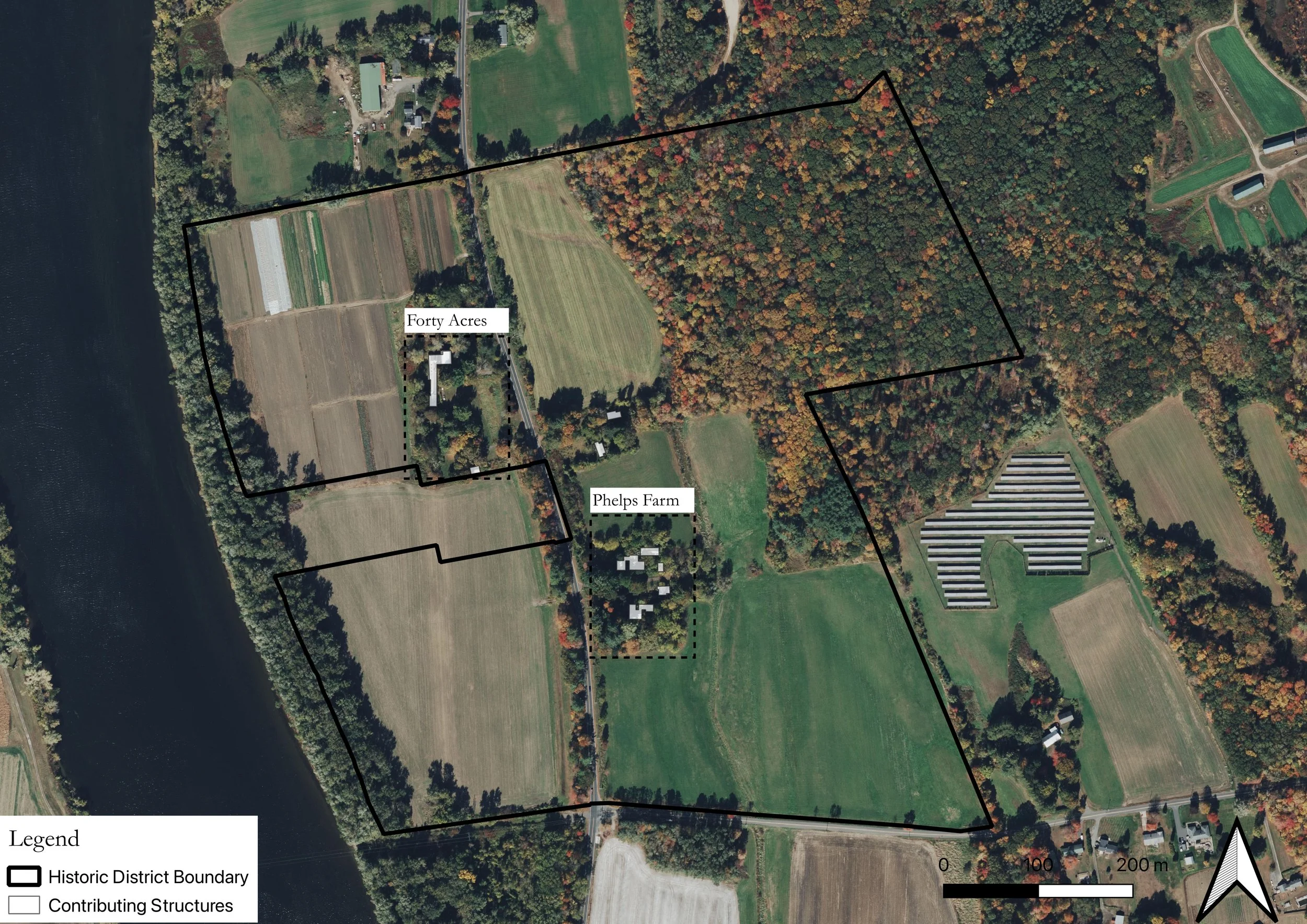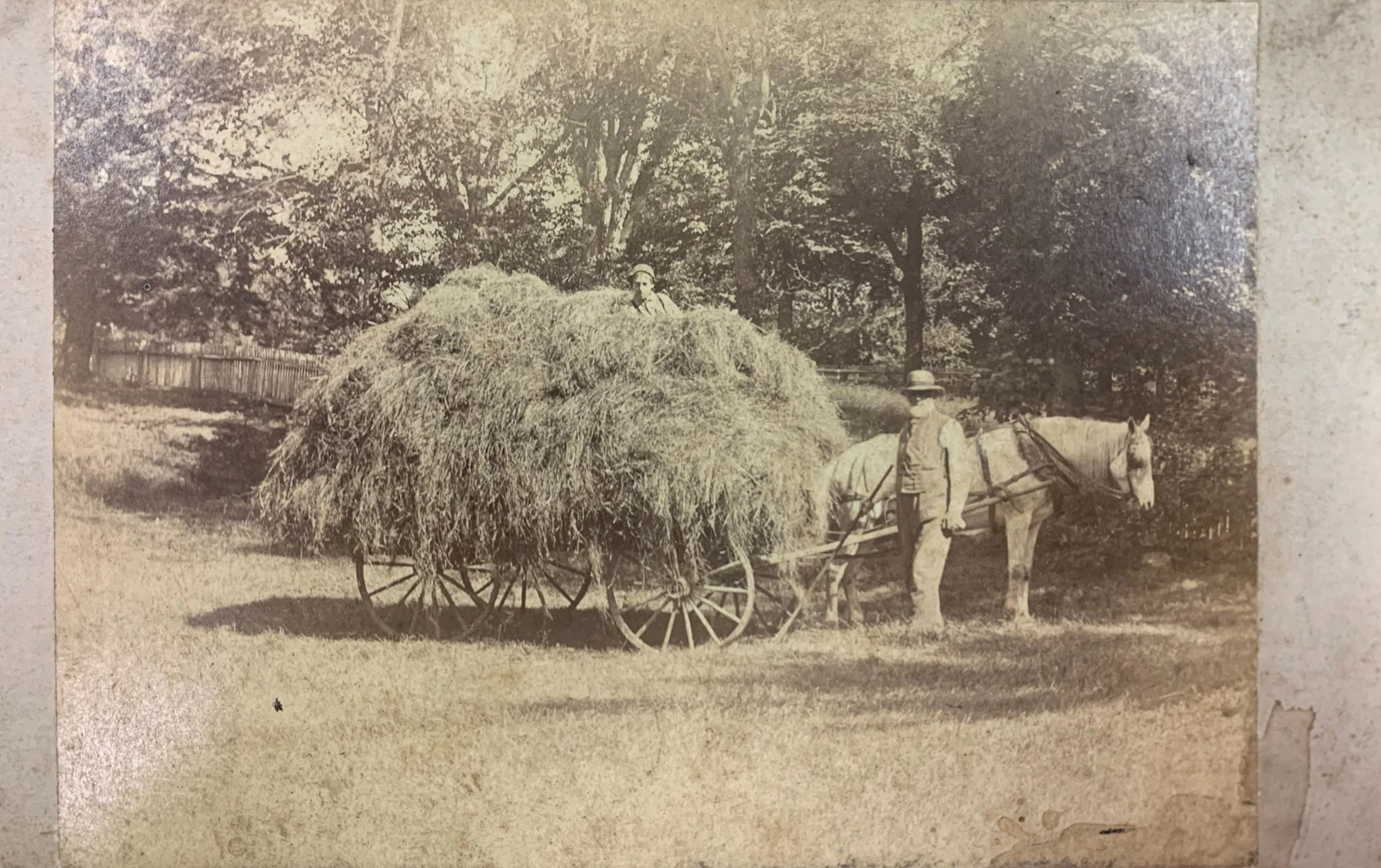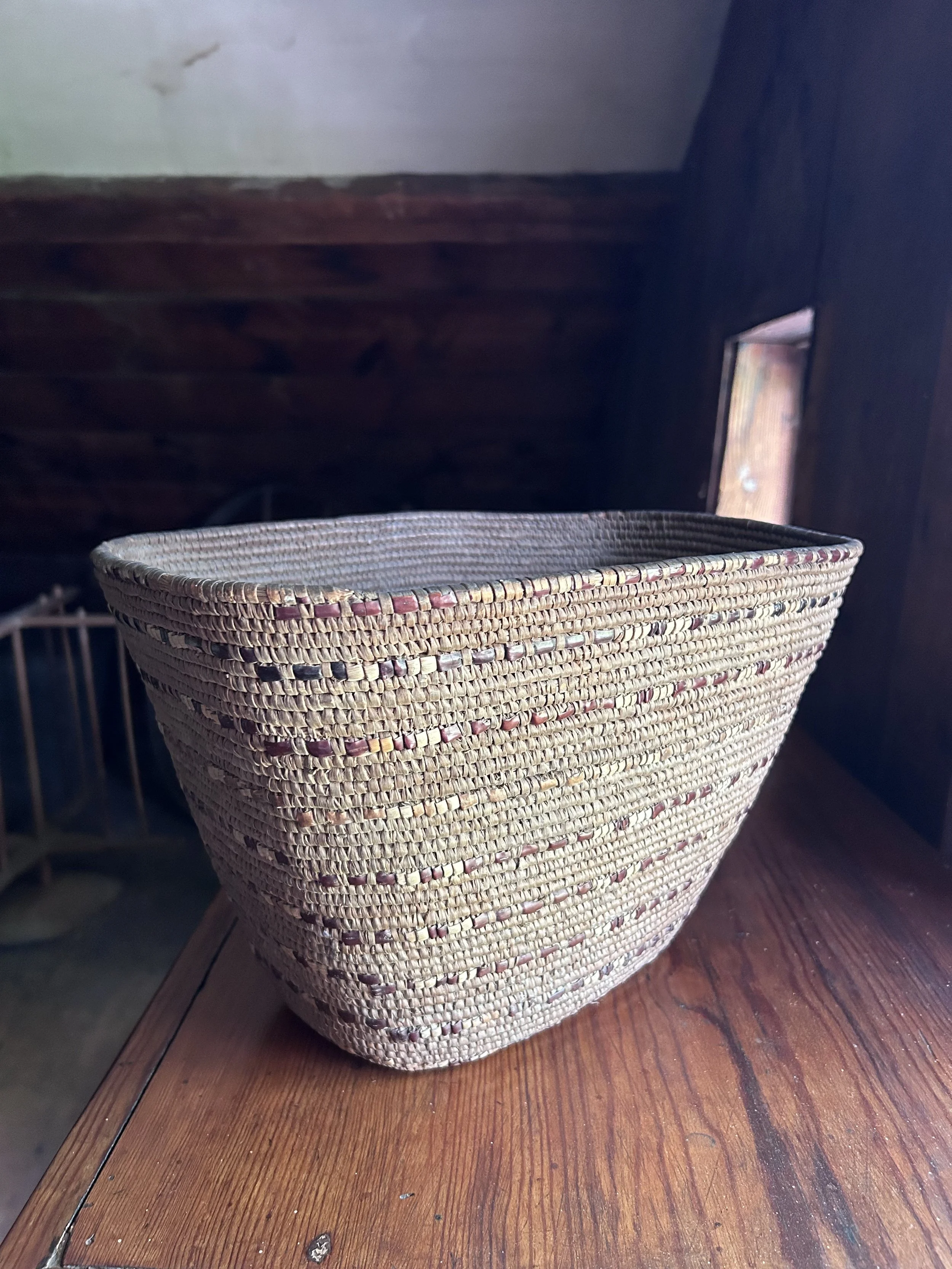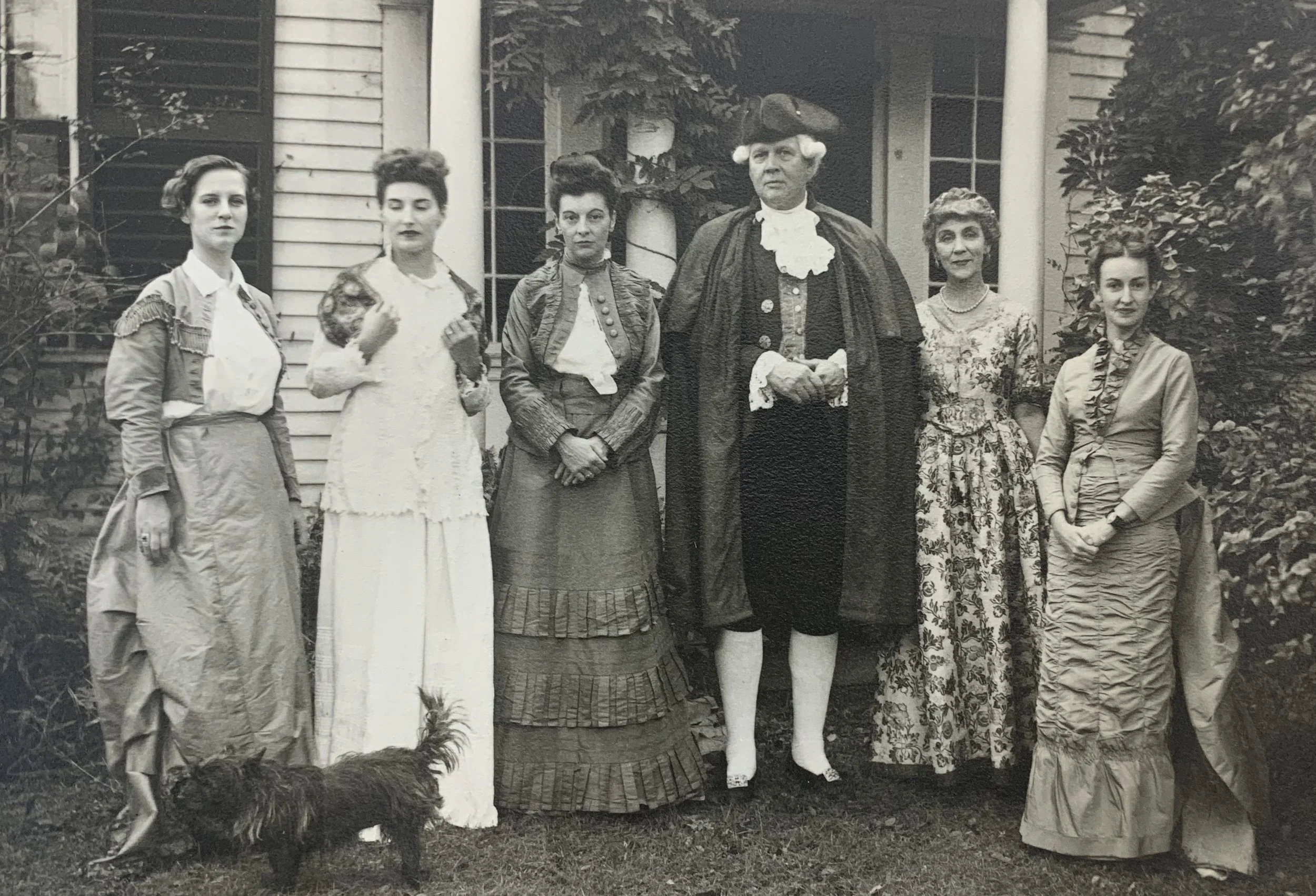Forty Acres and Its Skirts National Register Historic District
Since 1973, the Porter-Phelps-Huntington Museum has been individually designated in the National Register of Historic Places—the official list of the nation's historic places worthy of preservation. On May 4, 2023, this existing documentation was joined by the creation of the “Forty Acres and Its Skirts” National Register historic district by the National Park Service. The new 114-acre district marked the culmination of of a multi-year initiative to update and expand the museum’s existing designation which only included the museum house at Forty Acres and its historical associations with “Architecture” and “Early Settlement.” In contrast, the enlarged district includes several additional historical resources and landscape features at Forty Acres, the extensive outbuilding complex and Federal-style farmhouse at Phelps Farm, the Elizabeth Huntington Dyer Field and Forest Conservation Area co-owned by the museum and the Kestrel Land Trust, and several acres of farmland managed in conjunction with the Commonwealth’s Agricultural Preservation Restriction Program. Funded through a National Park Service Underrepresented Communities Grant awarded by the National Park Service to the Massachusetts Historical Commission in 2020, the new historic district now details the site’s significant associations with agricultural history, women’s history, Black and African American history, Indigenous history, architecture, and “pastkeeping” in the Connecticut River Valley. Access the new nomination documentation here or through the Massachusetts Cultural Resource Inventory System (MACRIS). View a presentation on the new historic district here.
Boundary of the Forty Acres and Its Skirts Historic District, 2023.
Process and Methodology
Upon receiving the NPS Underrepresented Communities Grant, the Massachusetts Historical Commission contracted with Marla Miller, PhD—UMass Amherst Distinguished Professor of History—and Brian Whetstone, PhD—then-PhD candidate in History at the University of Massachusetts Amherst—in 2021 to complete the new National Register of Historic Places nomination. Beginning in June 2021, Miller and Whetstone compiled and synthesized extensive research done at Forty Acres since 1973 that included a 1988 historic structures report on the museum house, a 1989 historic structures report completed by Kari Federer on the Corn Barn and Chaise House, and the work of scholars of early American history such as Christopher Clark (The Roots of Rural Capitalism: Western Massachusetts, 1790-1860) and women’s historians such as Elizabeth Carlisle (Earthbound and Heavenbent: Elizabeth Porter Phelps and Life at Forty Acres) and Marla Miller (The Needle’s Eye: Women and Work in the Age of Revolution and Entangled Lives: Labor, Livelihood, and Landscapes of Change in Rural Massachusetts). Additionally, Miller and Whetstone completed significant original archival research drawn from the exciting discovery of Charles Porter Phelps’ “adventures”—receipt bundles from his time as a merchant in Boston from 1799-1816—as well as archival collections retrieved from the attic of the farmhouse at Phelps Farm, Phelps Farm account books held by Harvard University’s Baker Library, and the Porter-Phelps-Huntington Family Papers held by UMass Amherst’s Special Collections and University Archives. UMass Amherst PhD students Alison Russell and Erika Slocumb augmented these research findings by researching Phelps’ entanglement in the Atlantic slave economy and researching the lives of free Black residents of Hadley in the nineteenth century, respectively. Finally, the nomination required extensive technical documentation, including generating floor plans, architectural descriptions, and nearly 100 photographs documenting Forty Acres and Phelps Farm’s contemporary physical conditions. Once completed in June 2022, the nomination went through a multi-step review process with the Massachusetts Historical Commission and the National Park Service before entering the National Register. Read more about the nomination’s findings below.
Findings
Frederic Dan Huntington at Forty Acres, circa 1900.
Agricultural and Labor History
At its height, the farm at Forty Acres extended to over more than 600 acres; in time, it encompassed a second household established at Phelps Farm, and the two sites have remained deeply entwined. Importantly for this effort to expand documentation of underrepresented communities, the district is a rare survival of a well-documented site that reflects the wide range of laborers and labor systems underpinning the agricultural economy over this period, from enslavement (over three generations of enslaved workers) and indentured servitude in the earliest periods to systems of tenancy and both seasonal and task-based hiring, all of which encompassed white, Indigenous, immigrant, and free Black laborers.
The buildings and land together constitute an unusually well-preserved district that reflects the long history of agriculture in the Valley and every one of its major economic, social, and cultural trends.
Doheny Sessions, former PPH museum director and operator of Phelps Farm, poses in front of a portrait of Charles Porter Phelps in Phelps Farm’s library, circa 1950.
Women’s History
As ownership of the properties at Forty Acres and Phelps Farm largely passed through maternal lines, the district’s story is inherently one of women’s history. The district is also a rare survival that documents Black women’s work in both enslavement and freedom; it is also a significant example of a site that engaged Native women’s work in domestic service in the late 18th century, making the historic district significant at the local level in the area of Women’s History. Both Forty Acres and Phelps Farm document women’s work in the dairy industry through the full arc of the period of significance, from Elizabeth Pitkin Porter (1719–1798) in 1752, the dairying work of Elizabeth Porter Phelps, Ruth Huntington Sessions (1859-1946), and Doheny Hackett Sessions (1905–1994) and her family, to 1978, when the dairy herd was sold.
Plate 22 in Asher Benjamin’s pattern book for a mantelpiece in Phelps Farm.
Architecture
The Forty Acres Main House is an excellent example of Georgian- and Federal-style architecture, and one of the earliest and best preserved examples of a center-hall-plan house in all of western Massachusetts (and the earliest in Hadley). Additionally, the Charles Porter Phelps Farmhouse at Phelps Farm, while in a deteriorated state, is among the best examples of Federal-style domestic architecture in Hadley, is probably the most intact, and is closely associated with the influential architect Asher Benjamin (1773–1845), whose published pattern books helped popularize Federal-style architecture in the early United States. The Outbuilding Complex at Phelps Farm documents the scale and layout of the Farmyard and farm complex, mainly during its 20th-century life as a prominent local dairy farm. Its collection of barns and farm outbuildings represent the evolution of farming practices in Hadley as they continuously adapted to new and ever-changing agricultural methods, conditions, and technologies.
Caesar, a Black man enslaved at Forty Acres, sent this letter to Charles Phelps in 1776.
Black History
The district preserves important themes in African-American history locally, regionally, and across the Atlantic world (that is, the interconnected social and political relationships structured through migration, colonialism, and the Atlantic slave and commodity trades, fostered across the Atlantic basin), making the historic district significant at the local level. Enslaved residents of these grounds include Zebulon Prutt, Peg, Phillis, Rose, a second Phillis, and Caesar Phelps. After slavery was made illegal in Massachusetts, the families of both Forty Acres and Phelps Farm also made regular use of free Black labor, including that of once-enslaved men (including Joshua Boston and Ralph Way, who worked on the crew that completed the construction of Forty Acres’ 1797 Ell) and women, and dairywoman Sarah Jackson, who labored in Forty Acres’ extant dairy. The district is also deeply entangled in the Atlantic slave economy: in the decades between the end of enslavement in Massachusetts and the U. S. Civil War, Charles Porter Phelps (1772–1857) engaged heavily in commerce dependent on slavery in the Caribbean and U.S. South, particularly Cuba and South Carolina, generating revenue offsite that made Phelps Farm viable. The documents associated with Phelps’s commercial endeavors are comprehensive in detail and the only known for a property in Hadley.
Objects like this woven grass basket (B031), acquired by Frederic Dan Huntington in upstate New York, speak to the survivance of Indigenous women and their work at Forty Acres.
Indigenous History
The Forty Acres and Its Skirts Historic District reflects two key themes in local, regional, and national history: the dispossession of Native peoples of their traditional homelands, and the persistence of those peoples on the land. In the latter case, though conventional wisdom holds that Native people had been displaced from this section of the Connecticut Valley by the mid-18th century, the family at Forty Acres employed at least three Native women as domestic servants in the late 18th and early 19th century. The extant dairy spaces on the property and documented presence of Native women within them are rare, well-documented survivals reflecting Native persistence on this ground, establishing the historic district’s significance at the local level in the area of Native American History.
Museum founder James Lincoln Huntington (center-right) poses in 1945 wearing the cape of his ancestor, Charles Phelps.
Cultural History and “Pastkeeping”
This nomination documents the district’s significance at the local level as an exceptionally well-preserved and extraordinarily well-documented site that traces the emergence, in the wake of contraction in the agricultural economy, of new interest in cultural economies. In particular, this historic district illustrates the ways in which elite New England families embraced and altered the built environment that both reflected and drove larger regional trends in the history of “pastkeeping”—that is, public history and particularly the histories of publication, historic preservation, and museum making. These themes intersect with larger national trends involving the Colonial Revival, the history of historic preservation, and post-World War I enthusiasm around American history and the decorative arts alongside subsequent, countervailing interest in the material culture of labor. Together these site-based themes illuminate evolving understanding of the New England past: how it has manifested and the evolution of priorities that has shaped how the buildings and landscapes have been preserved.






